How to connect a hydraulic accumulator to a water supply system
In order to prevent the pump from turning on every time the tap is opened, a hydraulic accumulator is installed in the system. It contains a certain volume of water, sufficient for a small consumption. This allows you to practically get rid of short-term pump starts. Installing the accumulator is a simple procedure, but a certain number of devices will be required - at least - a pressure switch, and it is also desirable to have a pressure gauge and an air vent.
The content of the article
Functions, purpose, types
In the water supply system of a private house without a hydraulic accumulator, the pump turns on whenever there is a water flow somewhere. These frequent inclusions lead to equipment wear. And not only the pump, but the entire system as a whole. After all, every time there is an abrupt increase in pressure, and this is a water hammer. To reduce the number of pump activation and smooth out water hammer, a hydraulic accumulator is used. The same device is called an expansion or membrane tank, a hydraulic tank.
Appointment
One of the functions of hydraulic accumulators is to smooth out water hammer, we found out. But there are others:
- Reducing the number of pump starts. There is some water in the tank. At a low flow rate - wash your hands, wash yourself - water flows from the tank, the pump does not turn on. It will turn on only when there is very little of it left.
- Maintaining a stable pressure. For this function, one more element is needed - a water pressure switch, but they maintain the pressure within the required limits.
- Create a small supply of water in case of a power outage.
It is not surprising that this device is present in most private water supply systems - there are many advantages from its use.
Views
The hydraulic accumulator is a sheet metal tank divided into two parts by an elastic membrane. The membrane is of two types - a diaphragm and a balloon (pear). The diaphragm is fastened across the tank, the pear-shaped balloon is fixed at the inlet around the inlet pipe.
By appointment, they are of three types:
- for cold water;
- for hot water;
- for heating systems.
Heating tanks are painted red, water tanks are blue. Expansion tanks for heating are usually smaller and cheaper. This is due to the material of the membrane - for water supply, it must be neutral, because the water in the pipeline is potable.
Accumulators are horizontal and vertical by type of location. The vertical ones are equipped with legs, some models have plates for hanging on the wall. It is the upward-stretched models that are more often used when independently creating water supply systems for a private house - they take up less space. The connection of this type of accumulator is standard - through a 1-inch outlet.
Horizontal models are usually equipped with pumping stations with surface-type pumps. Then the pump is placed on top of the container. It turns out compactly.
Principle of operation
Radial diaphragms (in the form of a plate) are used mainly in gyro-accumulators for heating systems. For water supply, a rubber bulb is mainly installed inside. How does such a system work? While there is only air inside, the pressure inside is standard - that which is set at the factory (1.5 atm) or which you set yourself.The pump turns on, starts pumping water into the tank, the pear begins to increase in size. The water gradually fills an increasing volume, more and more compressing the air that is between the tank wall and the membrane. When a certain pressure is reached (usually for one-story houses it is 2.8 - 3 atm), the pump turns off, the pressure in the system stabilizes. When you open a tap or another flow of water, it comes from the accumulator. It flows until the pressure in the tank drops below a certain mark (usually about 1.6-1.8 atm). Then the pump turns on, the cycle repeats again.
If the flow rate is large and constant - you type a bathroom, for example, - the pump pumps water in transit, without pumping it into the tank. The tank starts to fill up after all the taps are closed.
The water pressure switch is responsible for turning the pump on and off at a certain pressure. In most hydraulic accumulator piping schemes, this device is present - such a system works in optimal mode. We will consider the connection of the accumulator a little below, but for now let's talk about the tank itself and its parameters.
Large tanks
The internal structure of accumulators with a volume of 100 liters and above is slightly different. The pear differs - it is attached to the body both above and below. With such a structure, it becomes possible to fight the air that is present in the water. For this, there is an outlet in the upper part, into which a valve for automatic air release can be connected.
How to choose the volume of the tank
The volume of the tank can be chosen arbitrarily. There are no requirements or restrictions. The larger the tank, the more water you will have in case of shutdown and the less often the pump will turn on.
When choosing a volume, it is worth remembering that the volume that is in the passport is the size of the entire container. There will be almost half the water in it. The second thing to keep in mind is the overall dimensions of the container. A 100 liter tank is a decent one - about 850 mm high and 450 mm in diameter. For her and the harness, you will need to find a place somewhere. Somewhere - this is in the room where the pipe comes from the pump. Usually all the equipment is installed there.
If, in order to choose the volume of the accumulator, you need at least some guidelines, calculate the average flow rate from each draw-off point (there are special tables or you can look in the passport for household appliances). Summarize all this data. Get the possible expense if all consumers work simultaneously. Then figure out how many and what devices can work at the same time, count how much water will leave in this case per minute. Most likely by this time you will have come to some kind of decision.
To make it a little easier, let's say that the volume of a hydraulic tank of 25 liters is enough to meet the needs of two people. It will ensure the normal functioning of a very small system: a crane, toilet, sink and small water heater... In the presence of other household appliances, the capacity must be increased. The good news is that if you decide that the existing reservoir is not enough for you, you can always install an additional one.
What should be the pressure in the accumulator
In one part of the accumulator there is compressed air, water is pumped into the second. The air in the tank is under pressure - the factory setting is 1.5 atm. This pressure does not depend on the volume - it is the same on a 24 liter tank and 150 liters. More or less can be the maximum permissible maximum pressure, but it does not depend on the volume, but on the membrane and is indicated in the technical specifications.
Pre-check and pressure correction
Before connecting the accumulator to the system, it is advisable to check the pressure in it.The pressure switch settings depend on this indicator, and during transportation and storage the pressure could drop, so control is very desirable. You can control the pressure in the hydraulic tank using a pressure gauge connected to a special inlet in the upper part of the tank (capacity from 100 liters or more) or installed in the lower part of it as one of the trim parts. Temporarily, for monitoring, you can connect a car pressure gauge. His error is usually small and it is convenient for them to work. If this is not the case, you can use the standard one for water pipes, but they usually do not differ in accuracy.
If necessary, the pressure in the accumulator can be increased or decreased. There is a nipple for this at the top of the tank. A car or bicycle pump is connected through the nipple and, if necessary, the pressure is increased. If it needs to be vented, bend the valve of the nipple with some thin object, releasing air.
What air pressure should be
So should the pressure in the accumulator be the same? For normal operation of household appliances, a pressure of 1.4-2.8 atm is required. To prevent the tank membrane from breaking, the pressure in the system should be slightly higher than the tank pressure - by 0.1-0.2 atm. If the pressure in the tank is 1.5 atm, then the pressure in the system should not be lower than 1.6 atm. This value is set on the water pressure switch, which works in tandem with a hydraulic accumulator. These are the optimal settings for a small one-story house.
If the house is two-story, you will have to increase the pressure. There is a formula for calculating the pressure in the hydraulic tank:
Vatm. = (Hmax + 6) / 10
Where Hmax is the height of the highest draw-off point. Most often it is a shower. You measure (calculate) at what height its watering can is relative to the accumulator, substitute it in the formula, you get the pressure that should be in the tank.
If a jacuzzi is installed in the house, everything is more complicated. We'll have to select it empirically - changing the relay settings and observing the operation of the water points and household appliances. But at the same time, the working pressure should not be more than the maximum allowable for other household appliances and plumbing fixtures (indicated in the technical specifications).
How to choose
The main working body of the hydraulic tank is a membrane. Its service life depends on the quality of the material. The best today are food grade rubber membranes (vulcanized rubber plates). The body material is only relevant in membrane type tanks. In those in which the "pear" is installed, water contacts only with rubber and the material of the body does not matter.
What's really important about pear tanks is the flange. Usually it is made of galvanized metal. In this case, the thickness of the metal is important. If it is only 1 mm, after about a year and a half of operation, a hole will appear in the metal of the flange, the tank will lose its tightness and the system will stop working. Moreover, the warranty is only one year, although the declared service life is 10-15 years. The flange usually decays after the end of the warranty period. There is no way to weld it - very thin metal. You have to look for a new flange in service centers or buy a new tank.
So, if you want the accumulator to serve for a long time, look for a thick galvanized flange or a thin one, but made of stainless steel.
Connecting the accumulator to the system
Typically, the water supply system of a private house consists of:
- pump;
- hydroaccumulator;
- pressure switch;
- check valve.
In this scheme, a pressure gauge may also be present - for operational pressure control, but this device is not necessary. It can be connected periodically - for test measurements.
With or without 5-way union
If the pump is of the surface type, the accumulator is usually placed near it.In this case, the check valve is installed on the suction pipeline, and all other devices are installed in one bundle. They are usually connected using a five-way union.
It has leads with different diameters, just for the device used for piping the accumulator. Therefore, the system is most often assembled on its basis. But this element is completely optional and you can connect everything using ordinary fittings and pieces of pipes, but this is a more laborious task, besides there will be more connections.
With one inch outlet, the fitting is screwed onto the tank - the fitting is located at the bottom. A pressure switch and a pressure gauge are connected to the 1/4 inch outputs. The pipe from the pump and wiring to consumers are connected to the remaining free inch outputs. That's all the connection of the gyroaccumulator to the pump. If you are assembling a water supply circuit with a surface pump, you can use a flexible hose in a metal winding (with inch fittings) - it is easier to work with it.
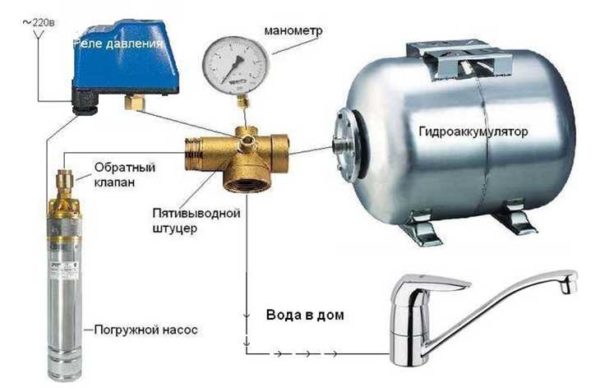
A clear diagram of the connection of the pump and the accumulator - where necessary, use hoses or pipes
As usual, there are several options, you can choose.
Connect the accumulator to the submersible pump in the same way. The whole difference is where the pump is installed and where to supply power, but this has nothing to do with installing a hydraulic accumulator. It is placed in the place where the pipes from the pump go. Connection - one to one (see diagram).
How to install two hydraulic tanks on one pump
When operating the system, sometimes the owners come to the conclusion that the available volume of the accumulator is not enough for them. In this case, you can install a second (third, fourth, etc.) hydraulic tank of any volume in parallel.
There is no need to reconfigure the system, the relay will monitor the pressure in the tank on which it is installed, and the viability of such a system is much higher. After all, if the first accumulator is damaged, the second will work. There is one more positive point - two tanks of 50 liters each cost less than one per 100. The point is in a more complex technology for the production of large-sized containers. So it's also more cost effective.
How to connect a second accumulator to the system? Screw a tee onto the input of the first one, connect the input from the pump (five-way fitting) to one free output, and the second container to the remaining free output. All. You can test the circuit.

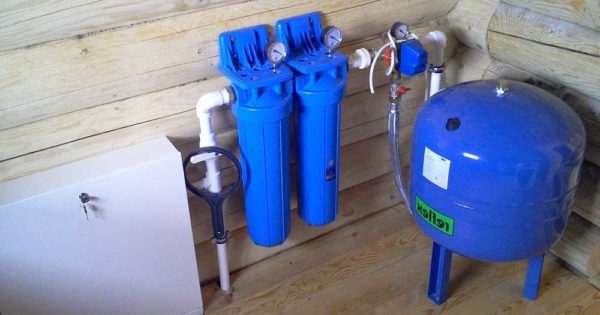
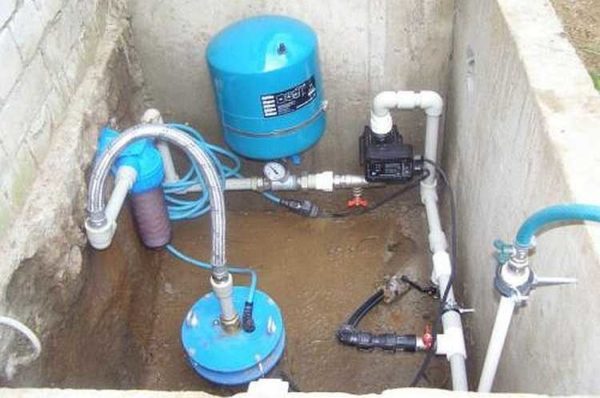
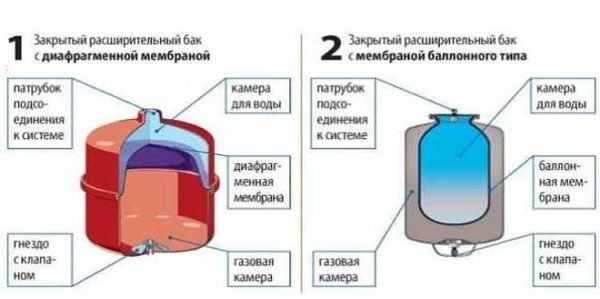
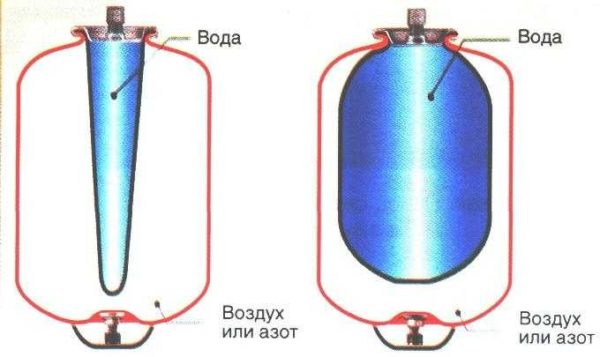
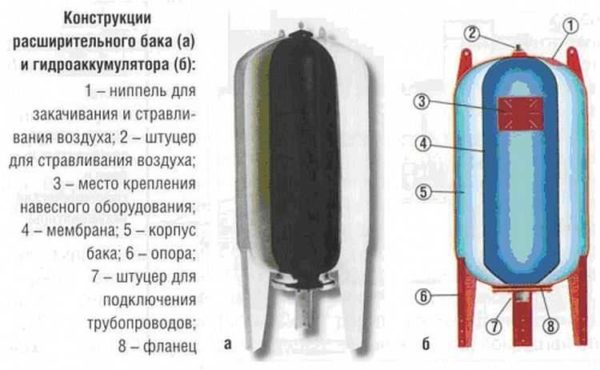
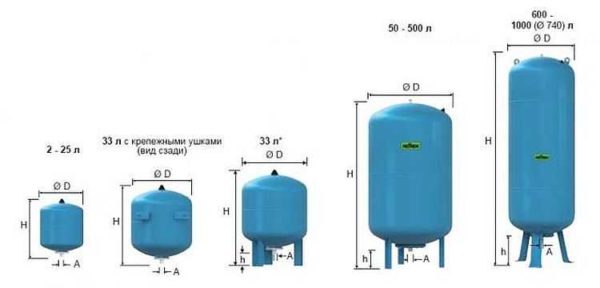
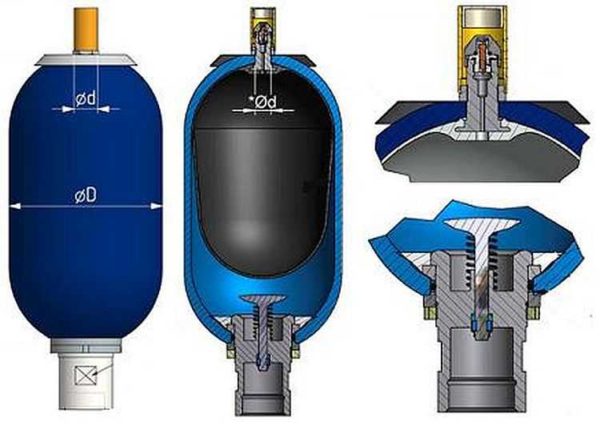
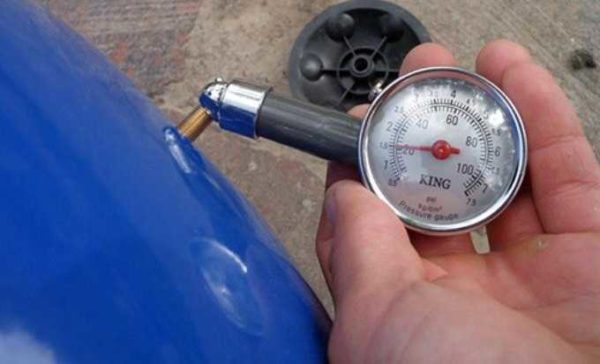
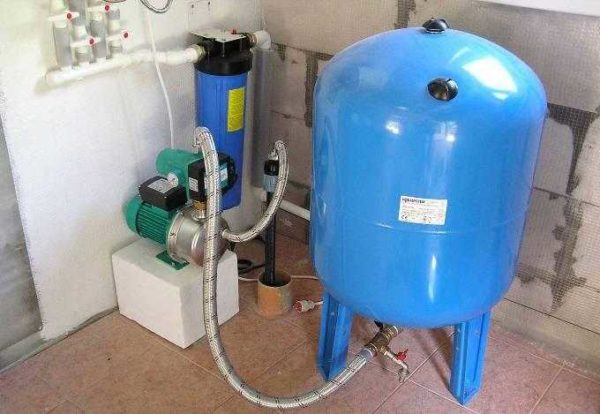
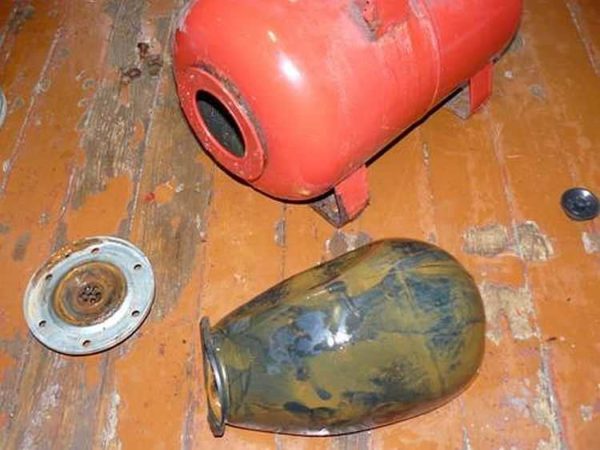
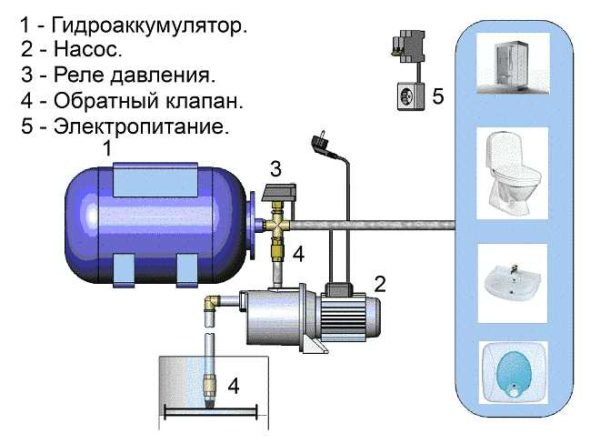
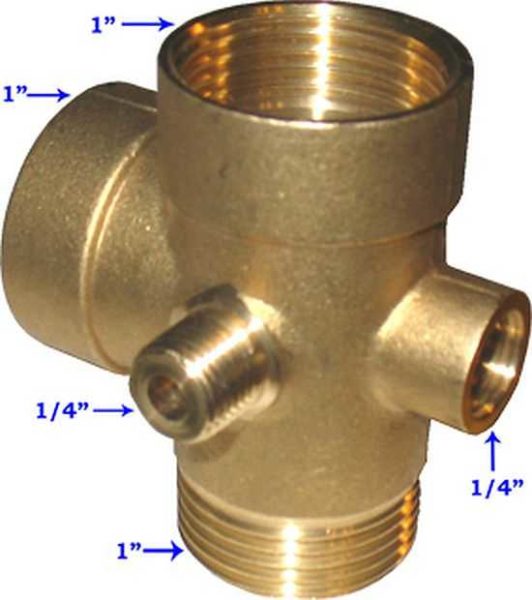
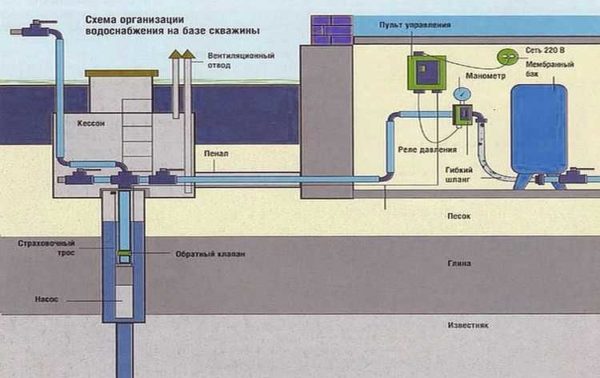
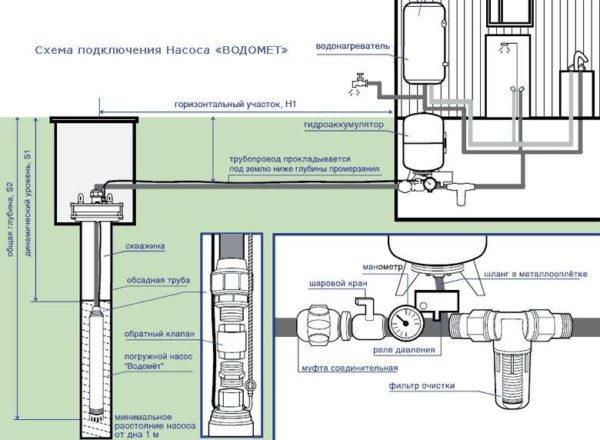
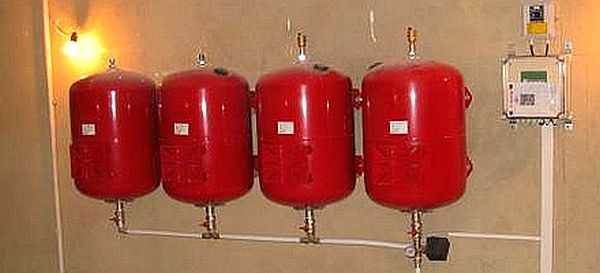
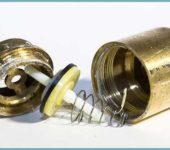


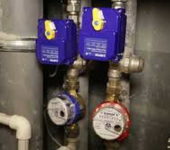






thanks for reviewing the topic! but tell me - why is it written on the tank 150 liters volume, and on the taken out pear during the repair, the inscription is 80-100 litas. ? is the volume of the pear always less than the specified volume on the accumulator? is there a percentage dependence?
The volume of the pear is always less because it is not designed to fill the entire volume of the hydraulic tank